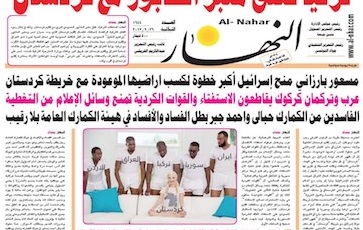Washington Kurdish Institute
October 2, 2017
After years of economic warfare by Baghdad which did not cease even as the Kurdish people and all other Iraqis resisted the existential threat posed by the brutal Islamic State (ISIS) terror organization, Iraqi Kurdistan held an independence referendum and it yielded the expected result – the overwhelming majority of residents of Iraqi Kurdistan chose to break free of Baghdad’s jurisdiction and build their own future within a new state. In the days leading up to the referendum, Iran and Turkey, often foes over the past few years, found common ground in threatening the people of Iraqi Kurdistan against holding a referendum, and then enacting harsh measures against Iraqi Kurdistan and threatening violence after the vote took place. The Iraqi central government also found common ground with both of these neighboring states, and immediately took harsh measures against Iraqi Kurdistan and engaged in rhetoric that, while referencing constitutional principles, was replete with threats and racism. Unsurprisingly, the rhetoric of the masses followed.
One example which has gained increasing infamy over the last few eventful days is an image published in the Iraqi newspaper an-Nahar, which is viewed as sympathetic to the Islamic Da’wa Party of Iraqi Prime Minister Haider al-Abadi and his predecessor, Nouri al-Maliki. This image shows five black men in undergarments staring lustily at a young, seemingly unaware white woman. The men are labelled as Jordan, Iraq, Turkey, Syria and Iran, and the woman is labelled Kurdistan. The implication is clear – this image embraces racist depictions of black men as hypersexual, and implies that the Jordan and the four states that have occupied Kurdistan will sexually exert their power over Kurdistan, an outnumbered, powerless, and seemingly oblivious young woman.
It should go without saying that this depiction of black men is unacceptable, and this use of sexual imagery to threaten the people of Kurdistan is truly revolting. Any further discussion of this propaganda technique requires a deeper look into the mindset behind by this image – a mindset in which might makes right and a man shows (or proves) his strength by physically and sexually dominating an opponent. This is, indeed, the unambiguous message of this image, and the Iraqi editorial staff at an-Nahar show us that they believe that being depicted as a strong sexual aggressor is something to be proud of, just as Kurdistan should be ashamed of being the victim of sexual assault. This misogynistic mindset is anything but novel, and is played out time and time again in wars and times of instability, as women are, more often than not, the worst victims when a people is threatened. In this image, the male figures are dominant, and the female is unknowing and powerless, and the force which will be exerted upon the female is a victory for the men’s side. The image and its message are horrifying, even without any additional specific historical context.
Sadly, plenty of contexts provided by recent Iraqi history make the threat implicit in this image all the more jarring. The regime of Saddam Hussein, which persecuted all Iraqis and perpetrated a genocide against the Kurdish people at what was arguably the height of its brutality, institutionalized the use of rape as a tool to control the population. As documented in Iraqi author Kanan Makiya’s Cruelty and Silence, the Iraqi army under the dictator Saddam Hussein employed men who included in their job description the “violation of women’s honor” (i.e., rape), which was one of many tools used to exert dominance and guarantee submission to the regime in all ways possible. Outside the formal military hierarchy, rape was most infamously used by Saddam’s eldest son and former heir apparent, Uday Saddam Hussein, who had a reputation for driving around Baghdad to pick women to bring back to one of his palaces, and sometimes these women were never seen again.
The children born during the last years of the nightmare that was Saddam’s reign are now entering adulthood, and they deserve a life free from the violence and misogyny. All Kurds and all Iraqis must reject these threats and this type of discourse, and loudly condemn these attempts to use memories of some of the most brutal of Saddam’s tactics to repress free expression and dissent. The High Council for Women’s Affairs of the Kurdistan Regional Government (KRG) has issued a statement of condemnation, and all should be joining them in expressing this rejection of such racist and violent imagery. Even those who do not have a shared view on the best borders for what is now Iraq should be united in this regard.

